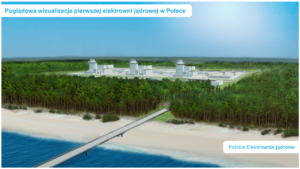Can Poland run its energy transition on natural gas and not fall into Putin’s gas trap? There is a way, but it’s risky – writes Wojciech Jakóbik, editor-in-chief at BiznesAlert.pl.
Energy transition running on natural gas, but hopefully not from Russia
The Polish energy transition involves a gradual shift away from coal in favor of renewable energy with nuclear power and natural gas playing the role of baseload. Due to the energy crisis fuelled by Russia, which showed it makes little sense to rely on natural gas, the participation of natural gas-fired energy in the energy mix is supposed to be smaller than expected.
Despite this, Daniel Obajtek’s company continues to rely on gas. Orlen predicts that the demand for gas will reach 30 billion cubic meters in 2030. Gaz-System estimates that it may be lower: 26-28 billion cubic meters. „We will invest in modern gas-fired energy. It will be the foundation for the development of RES, because it will stabilize the electricity system,” said Robert Śleszyński, Director for Capital Investments at PKN Orlen during the presentation of the Group’s new strategy.
Orlen expects that its gas-fired power plants will stabilize the power system, which will increasingly rely on renewables.
Meanwhile, Gaz-System’s National Ten-Year Plan Until 2035 assumes that the annual demand for gas will reach 26-28 billion cubic meters in 2030. The previous version estimated that the demand would reach up to 35 bcm a year. The gas demand is 10-15 percent lower in the new forecast because of the energy crisis fuelled by Gazprom, whose actions led to a situation where everybody will think twice before using natural gas as a transition fuel. That’s why Daniel Radomski wrote on BiznesAlert.pl that Poland has turned back from the march towards the gas trap, which we have been warning about on the portal since 2020.
The Polish Nuclear Energy Program assumed that without the atom, Poland’s energy sector alone may need even 19 bcm annually, as new gas-fired power plants will be needed to stabilize renewables. In 2020, I wrote that such a policy could condemn Poland to returning to Russian gas, and perhaps supplies via the Nord Stream 2 gas pipeline, which has since been decommissioned after the sabotage in September 2022.
McKinsey presented similar data in relation to Germany. The company estimated that Germany would need 21 (!) new gas-fired power plants to go through the energy transition without nuclear power. This would cause gas demand to soar to a point where it would exceed the capacity of the five LNG terminals planned in Germany, which are expected to provide 30 billion cubic meters annually from outside Russia, and therefore could force the Germans to return to importing Russian gas at some stage in the future. From this point of view it would be better to adopt the solution from the beginning of the energy crisis – use coal longer, which is being done in Poland, the Netherlands and Germany, go back to discussions on nuclear energy and move to the RES-atom duo with a tinge of non-Russian gas. In this context the Ostrołęka C Power Plant is symbolic. This project of a new coal block, which was supposed to provide energy from 2023 under an agreement with the European Commission, was switched to gas. Now this plan may experience problems due to the energy crisis and requires new sources of gas from the Poland-Lithuania gas pipeline, so as not to buy Russian gas via the Yamal gas pipeline that was turned off in the spring of 2022.
Does this mean that the energy transition of Poland as envisaged by Orlen is doomed to bring the country back to dependence on Russia? There is a way for Poland to run its transition on natural gas without falling into Putin’s trap.
If not from Russia, where should Poland get gas?
First, the Orlen group wants to extract 12 billion cubic meters of gas annually in 2030, and therefore meet almost half of Poland’s demand with its own production. This is an ambitious plan, but it can be implemented on the assumption that there will be no problems with financing investments in fossil fuels.
Secondly – atom, but small and scattered. „Until 2030, we will be investing in individual SMRs, but after 2030 we expect a rapid growth, as this technology will be commercialized and more mature,” said Robert Śleszyński, Orlen Director for Capital Investments. „We assume that the investments will be bankrolled not just with our balance sheet, but also thanks to partnerships, structure financing and project finance. We want to create an offer, in which different funds will want to engage in,” he added. While this plan is ambitious, it is also welcome, as it will decrease the role of natural gas in the power industry. However, it may require billions of additional investments with a limited banking market that loans money to bankroll hundreds of energy transition projects. This is where the funds from the National Recovery Plan for companies to which Poland still does not have access enter the stage. However, Orlen sees the role of SMRs somewhat differently. „SMRs will replace conventional power plants that today run on coal. They will be shut down in some time, ” Śleszyński admitted. „At the end of April, we will present the location and progress our partners made on this important project,” revealed Orlen CEO Daniel Obajtek. PKN Orlen cooperates with GE Hitachi and Synthos Green Energy on the implementation of the BWRX-300 technology in Poland. By the end of the decade, the technology will be commercialized in Canada and then in Europe. It should therefore be noted that the Orlen nuclear plan is based on the assumption that GE Hitachi technology will definitely enter the market.
Poland may have natural gas
The next element of the solution is renewable gases: hydrogen and biomethane, which play an important role in Orlen’s strategy, but not only. PKN Orlen wants to produce one billion cubic meters of biomethane, which would be a domestic alternative to natural gas, also from Russia. The company also plans to produce about 60 tons of hydrogen per day in ten hydrogen hubs, the first of which was supposed to have been developed at a petrochemical facility in Trzebinia giving 50 kg of hydrogen per hour. This fuel, which is a renewable gas used in gas-fired power plants after adjustments, is also an alternative to natural gas. It can also be produced from surplus renewable energy, for instance the planned 9 GW of renewable energy from Orlen’s strategy, including 1.2 GW in offshore wind farms by 2024.
The aforementioned Gaz-System also believes renewable gases will play a role in meeting Poland’s gas demand. The company submitted three hydrogen transport and storage projects to the European Union’s programme of Projects of Common Interest (PCI). This means they may become of importance to the EU and get half of the funding from the EU, just like the LNG terminal in Świnoujście. The EU TEN-E regulation allows investment in hydrogen transmission infrastructure, which I personally cal „hydropipes”. The projects submitted by Gaz-System include the Nordic-Baltic Hydrogen Corridor to transport hydrogen from Finland (produced with nuclear power too!), the National Hydrogen Framework, which will make it possible to use gas pipelines and a gas storage facility in Damasławek to distribute hydrogen. The third project involves the storage of hydrogen in a facility in Damasławek. It is also a way to avoid stranded assets in the gas sector. Infrastructure designed to diversify gas supplies may one day transport renewable gases and continue to pay off for decades. This echoes the work of Gaz-System in the European Association of Operators ENTSO-G, which is already working on the transition to hydrogen and other renewable gases, which I described in a piece titled „Nie węglowa, nie gazowa. Wielka Polska wodorowa.”
Better not to rely on just gas
Regardless of the fate of the above projects, the forecasts of gas demand in Poland once again emphasize the importance of nuclear energy, especially the large one. The Polish Nuclear Power Program assumes that atomic energy will reduce the peak energy demand for natural gas from 19 to even 10 billion cubic meters a year. It is worth adding that the surplus energy from the atom can also be used to produce hydrogen, whether in a large state-owned power plant or small SMRs from Orlen and other companies. Poland should not based its energy transition on gas, so as not to fall into Putin’s gas trap. Thankfully it has new opportunities in the nuclear and renewable gas sectors that will allow it to reduce risks.









